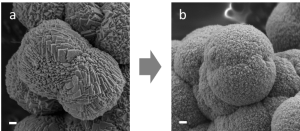Inspired by Nature: Changing Magnetism
Researchers at the Technion change the magnetic properties of materials
Israeli researchers have developed a new technique for controlling the magnetic properties of materials. The method draws inspiration from mineral growth processes by organisms in nature. The research was led and initiated by Prof. Boaz Pokroy and doctoral student Arad Lang from the Department of Materials Science and Engineering at the Technion – Israel Institute of Technology in Haifa, Dr. El’ad Caspi and his team of researchers from the Nuclear Research Institute in the Negev, and Dr. Giorgia Confalonieri and Dr. Catherine Dejoie from the European Synchrotron Radiation Facility (ESRF) in Grenoble, France.
Biominerals are structures created in nature by almost all animals for a wide variety of purposes, such as building the bones that support the body or the mollusk shell that protects the mollusk inside. These structures are characterized mostly by excellent mechanical properties, meaning they are relatively hard to break. One of the reasons for this is the fact that within the inorganic structure of the mineral, organic molecules (proteins) are integrated and serve as a sort of “glue” that prevents cracks from propagating within the mineral.
Inspired by this phenomenon, researchers in Prof. Pokroy’s lab grew crystals of the mineral manganese carbonate (MnCO3) in the presence of amino acids – the building blocks of proteins. It turns out that in this synthetic process, the organic molecules, that is the amino acids, also succeed in incorporating themselves into the crystal structure of the mineral. These molecules push the manganese and carbonate ions away from each other and create distortions in the structure of the host crystal.

Scanning electron microscope images of manganese carbonate crystals, without (a) amino acids and with (b) amino acids incorporated in the crystal. Scale bar: 200 nanometers.
The researchers then measured the magnetic properties of the crystals that were created. In the measurement, which was conducted at a very low temperature (2 K, about -270 degrees Celsius), it became clear that the new material – manganese carbonate that contains the amino acids – is characterized by a higher magnetic susceptibility than the original material, making it very easily affected by the activation of an external magnetic field. In addition, as the amount of amino acid in the material increases, the reaction of the material to the field becomes even stronger. It also became clear that the threshold temperature, that is the maximum temperature at which the material behaves magnetically, (also called the “Neel temperature”) dropped as a result of the introduction of the amino acids.
The reason for these changes is the distancing of the atoms from each other inside the crystal. This process causes the weakening of the magnetic interactions within it, so there is a stronger effect of the external field.

Illustration of the changes in the magnetic properties of manganese carbonate as a result of the incorporation of amino acids.
For the first time, this article presents the possibility of controlling the magnetic properties of materials by incorporating organic molecules that are not magnetic themselves. This study paves the way for using small, non-toxic molecules to change the magnetic properties of a wide variety of materials used in many fields, including medicine and microelectronics.
For the article in Advanced Materials click here




